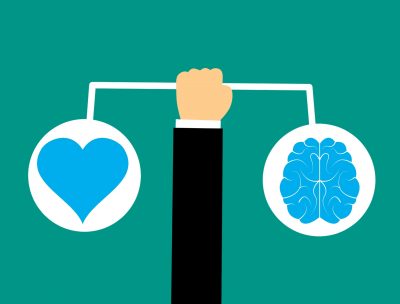Components of Emotions
Emotions are rapid information-processing systems that help us act with minimal thinking (Tooby & Cosmides, 2008). Problems associated with birth, battle, death, and seduction have occurred throughout evolutionary history and emotions evolved to aid humans in adapting to those problems rapidly and with minimal conscious cognitive intervention. If we did not have emotions, we could not make rapid decisions concerning whether to attack, defend, flee, care for others, reject food, or approach something useful, all of which were functionally adaptive in our evolutionary history and helped us to survive. For instance, drinking spoiled milk or eating rotten eggs has negative consequences for our welfare. The emotion of disgust, however, helps us immediately act by not ingesting them in the first place or by vomiting them out. This response is adaptive because it aids, ultimately, in our survival and allows us to act immediately without much thinking. In some instances, taking the time to sit and rationally think about what to do, calculating cost–benefit ratios in one’s mind, is a luxury that might cost one one’s life. Emotions evolved so that we can act without that depth of thinking.

Physiological Component of Emotion
Emotions prepare the body for action by simultaneously activating certain systems and deactivating others in order to prevent the chaos of competing systems operating at the same time, allowing for coordinated responses to environmental stimuli (Levenson, 1999). For instance, when we are afraid, our bodies shut down temporarily unneeded digestive processes, resulting in saliva reduction (a dry mouth); blood flows disproportionately to the lower half of the body; the visual field expands; and air is breathed in, all preparing the body to flee. One common misunderstanding many people have when thinking about emotions, however, is the belief that emotions must always directly produce action. This is not true. Emotion certainly prepares the body for action; but whether people actually engage in action is dependent on many factors, such as the context within which the emotion has occurred, the perceived consequences of one’s actions and previous experiences (Baumeister, Vohs, DeWall, & Zhang, 2007; Matsumoto & Wilson, 2008).

Behavioral Component of Emotion
Emotions prepare us for behavior and they are important motivators of future behavior. Many of us strive to experience the feelings of satisfaction, joy, pride, or triumph in our accomplishments and achievements. At the same time, we also work very hard to avoid strong negative feelings. For example, once we have felt the emotion of disgust when drinking the spoiled milk, we generally work very hard to avoid having those feelings again (e.g., checking the expiration date on the label before buying the milk, smelling the milk before drinking it, watching if the milk curdles in one’s coffee before drinking it). Emotions, therefore, not only influence immediate actions but also serve as an important motivational basis for future behaviors.
Emotions are expressed both verbally through words and nonverbally through facial expressions, voices, gestures, body postures, and movements. Research suggests that we are quite sensitive to the emotional information communicated through body language, even if we’re not consciously aware of it (de Gelder, 2006; Tamietto et al., 2009). The fact is that humans are constantly expressing emotions when interacting with others. Emotions and their expressions communicate information to others about our feelings and intentions.
Cognitive Component of Emotion
Emotions are also connected to thoughts and memories. Cognitive processes (thinking) play an important role in interpreting the events that triggered the emotional response in the first place. Imagine you are walking down a trail and you think you see a snake. Chances are physiological responses are happening automatically (rapid heartbeat and breathing, sweating, muscle tension) as your body prepares for action. Suddenly, you realize that it is not a snake on the trail but just a piece of climbing rope left behind. Your appraisal of the situation as non-threatening signals to your body that it can deactivate the arousal system. These appraisals are informed by our experiences, backgrounds, and culture. This means that different people may have different emotional experiences even when faced with similar circumstances.

Memories are not just facts that are encoded in our brains, they are colored with the emotions felt at those times the facts occurred (Wang & Ross, 2007). In this way emotions serve as the neural glue that connects those disparate facts in our minds. That is why it is easier to remember happy thoughts when happy, and angry times when angry. Emotions serve as the affective basis of many attitudes, values, and beliefs that we have about the world and the people around us. Without emotions those attitudes, values, and beliefs would be just statements without meaning, and emotions give those statements meaning. Emotions influence our thinking processes, sometimes in constructive ways, sometimes in unconstructive ways. It is difficult to think critically and clearly when we feel intense emotions, but easier when we are not overwhelmed with emotions (Matsumoto, Hirayama, & LeRoux, 2006).

